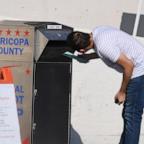Sandy Cruelly Wiped Out Ali Forney Center for Homeless Kids
Ali Forney Center turns away 150 homeless kids a night for lack of space.
Nov. 9, 2012— -- New York City youth who have been left homeless because of the hardship they face being gay and transgender got another knock when the Ali Forney Center was destroyed by Superstorm Sandy.
The storm surge took a cruel swipe, flooding the AFC's drop-in facility, a triage point for kids on the street who need medical care, HIV testing and housing referrals.
"This is a disaster in a disaster," said Executive Director Carl Siciliano. "These kids face disaster every day ... They are sleeping on rooftops, abandoned buildings and lots ride trains at night. It's been really rough with the subway shutting down."
The center, founded in 2002, was named for Ali Forney, a gay 22-year-old who was murdered by a shot in the head in 1997. He had been homeless since the age of 13, thrown out by his mother, and beaten up in foster care and group homes for his feminine behavior.
Resources for homeless LGBT youth are scarce and shelters are at capacity, especially in New York City where a study commissioned by the City Council estimated 3,800 youth are homeless, about 1,600 of them lesbian, gay, bisexual, transgender or questioning.
Four feet of water flooded the 1,000-square foot drop-in center on West 22nd Street, a half a block from the Hudson River in the city's mandatory evacuation zone, destroying computers, phones and medical equipment.
The day before Sandy hit, AFC staff referred youth to designated city shelters for food and medical care. But on the Friday after Monday's storm, when they were allowed back, they found devastation.
"Water had inundated the whole space," said Siciliano. "The floors were ruined. Salt water was in the electrical outlets. All of our food was off and supplies were gone. The fridge fell over and was floating around. Now, we can't even go in, the mold is so bad."
About 20 to 40 percent of youth who leave home to live on the streets identify themselves as LGBT, according to National Gay and Lesbian Task Force.
In one study, 26 percent of teens who came out to their parents were told they must leave home. Others said they were physically, sexually or emotionally abused. LGBT youth also reported that they are threatened, belittled and abused at shelters, not only by other residents, but by staff, as well.
The AFC had planned to relocate its drop-in center to a new site in Harlem for more space, but renovations have not even begun. So now, they are temporarily located in an LGBT community center.
About 150 kids a night arrive at the drop-in center looking for a bed, but AFC is only able to house 77, and the city only has 200 shelter beds designated for youth.
"Generally clients who have been couch-surfing find themselves in an emergency situation when a friend's mother no longer is willing to harbor them," said Jack Bethke, director of life skills at the Brooklyn service center. "They may find themselves sleeping in parks, piers, subways or port authority."
Their plight is bleakest during the winter, when they have no place to be safe and warm at night. Two back-to-back storms have taken a toll.
But AFC provides more than beds at its 10 service sites. They help youth find independence, helping them get an education and providing vocational services.
It was a lifeline for KC, a homeless 18-year-old who left home in Washington, D.C. and landed at the drop-in center after his mother made life difficult because he was gay.




